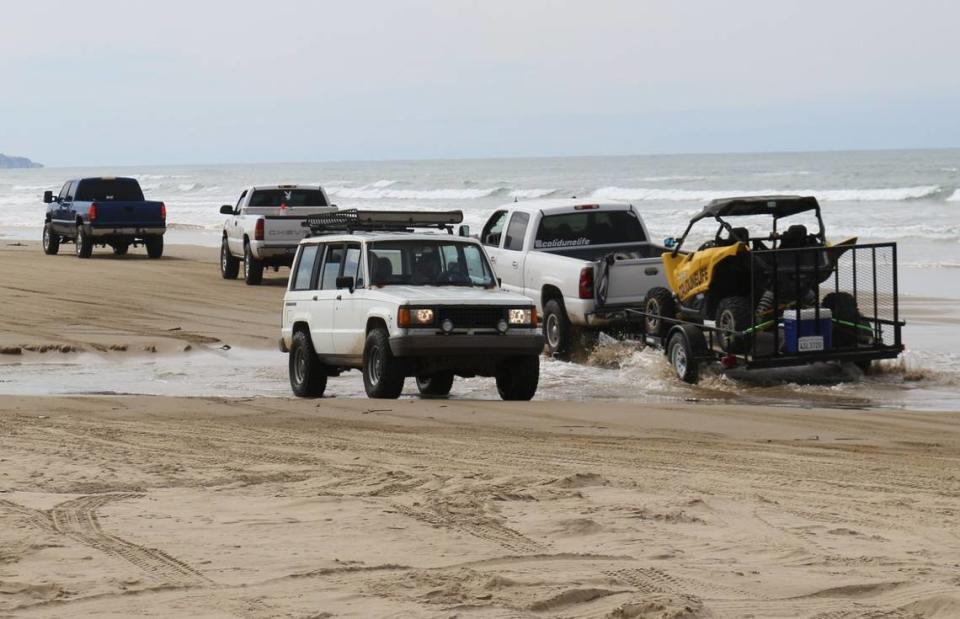What should happen to Oceano Dunes after off-roading ends? Study looks at future of region
What will happen to San Luis Obispo County’s southern coast after off-road riding ends at the Oceano Dunes?
A new study examines how to sustain and grow Oceano Dunes State Vehicular Recreation Area as an important regional economic driver, and offers recommendations on how to showcase the cultural sites and sensitive environment at the popular state park near Pismo Beach.
Off-highway vehicle use is expected to be banned in most of the park by 2024.
Released Thursday, the $87,850 study was conducted by global consulting firm Resonance and funded by Visit SLO CAL, Pismo Beach, Grover Beach, Arroyo Grande and San Luis Obispo County.
“Doing nothing (as off-roading stops) isn’t really an option,” said Chris Fair, president and CEO of Resonance. “We need to think about how we move forward as a destination to ensure that we’re ready to receive the visitors that are coming in the most sustainable way, both for the environment and for quality of life for local residents.
“Hopefully by working together, regardless of whatever the courts decide, the recreation area will be a stronger asset for the community and the county’s tourism industry for the long term.”
Based on cellphone geolocation data, about 3.4 million people walked, drove, biked or rode horses onto Oceano Dunes SVRA in 2019, the study estimated.
Around two-thirds of those were visitors from outside of San Luis Obispo County, the study said.
That likely resulted in a $511.2 million impact on the county in 2019, the study said.
“The goal of this study was to ask: If the dunes does fully close (to off-highway vehicles), then how can we offset some of the economic impacts that could harm our local community?” said Chuck Davison, president and CEO of Visit SLO CAL, SLO County’s tourism marketing and management organization. “How do we make sure there’s some dollars flowing in the direction of the local community in order to advance some of the recommendations you see in the report?”

California Coastal Commission votes to ban off-road riding
In March 2021, the California Coastal Commission voted unanimously to amend California State Parks’ coastal development permit for the popular recreation area. The commission voted to prohibit off-road riding in the dunes south of Pier Avenue in Oceano by 2024.
Banning off-roading south of Pier Avenue blocks the activity in all of the park’s dune area. Only a one-mile stretch of the beach north of Pier Avenue would be open to off-highway vehicles and vehicle camping, according to the amended permit.
Since the 2021 decision, off-roading advocacy groups have filed several lawsuits in San Luis Obispo Superior Court to fight for continued vehicle access. Those lawsuits are still ongoing.
One ‘potential scenario’ for Oceano Dunes
Although the Oceano Dunes are seen by many as primarily a place to drive ATVs, dirt bikes and cars on the beach and in the coastal dunes — it’s the only such area in the state — the study highlights the diversity of recreational opportunities the area has to offer.
The study notes that the South County region now has a great opportunity to revamp a vital, regional eco-tourism destination that could draw in crowds from around the world — even without the long-treasured vehicle access.
“In this potential scenario, the SVRA is now closed and Oceano Dunes has become a State Natural Reserve,” the study states. “After the closure, the diversity of landscapes is celebrated by locals and visitors. Already recognized as a Natural Wonder of the World by Californians, it is on the path to be recognized by UNESCO (United Nations Educational, Scientific and Cultural Organization).”
“The types of activities have shifted from being motorized to lower-impact outdoor activities,” it continues. “New audiences — from researchers to cultural enthusiasts — flock to the Dunes and enjoy low-impact infrastructure to explore the Dunes. An integrated boardwalk now connects all coastal communities with access to different types of experiences and environments. Eventually, visitors have become more out-of-state, as the world recognizes the importance of Oceano Dunes.”

Study has 20 recommendations for region’s future
The study released Thursday lays out a total of 20 recommendations — ranging from creating an Oceano Dunes stewardship committee to updating the park’s fee and reservation system, to enhancing and expanding trail systems in the park.
Davison said he hopes the recommendations can be used as guideposts for the state, county and local governments that control the park and its surroundings.
The creation of the Oceano Dunes stewardship committee with members representing a variety of interests in the park is paramount, Davison said.
Although a similar committee disbanded in 2017 due to disagreements on how to manage the park, Davison said he hopes this new committee could agree to the new future of the park.

Aside from the formation of a stewardship committee, the study suggests a multitude of improvements to the park and surrounding community.
Those include expanding a trail and walkway system within the park that has interpretive signage pointing out key ecological and cultural spots.
Visitors should be able to learn about the Oceano Dunes and its history and environmental characteristics while recreating in the unique coastal dune system, the study says.
Local communities should also invest in building the local tourism workforce and infrastructure surrounding the Oceano Dunes, the study says. Doing so would improve access to the park as well as better serve and house visitors, according to the study.
According to Fair, the future of the South County region around the Oceano Dunes is in the hands of the local governments and State Parks.
He said the study by his consultancy firm lays out a clear pathway toward ensuring the region becomes a sustainable tourism hub, he added.
“Rather than just saying ‘This is up to State Parks, or this is up to the county, or this is up to Grover Beach, or this is up to Oceano,’ really, it’s up to all of those parties working together in a coordinated fashion,” he said. “Hopefully the study creates the platform to at least begin that process.”


 Yahoo Sports
Yahoo Sports 